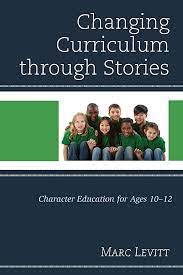How to Use Stories as Catalysts for Reflection
Changing Curriculum through Stories: Character Education for Ages 10-12
By Marc Levitt
(Rowman & Littlefield Publishers, 2017 – Learn more)
Reviewed by Kevin D. Cordi, Ph.D.

Too often the author’s focus is the moral and not the emotional impact of the narrative. However, after reading Changing Curriculum through Stories (2017) by Marc Levitt, I know it relies on the story to teach students.

Levitt knows that well told-stories can transfer to well-written stories. He has done the work in telling these stories in his travels. He knows they are road ready, so when he is writes them down, he can speak from how audiences responded to the story and recapture what drove them to listen.
Middle school students need stories that connect to their lives. Whether it is a folk or a personal tale, the narrative needs to be compelling and invite students to see themselves in the story. When I was a full-time high school teacher, story was part of my everyday curriculum, and teaching using narrative helped me make significant connections with my students
Humans are wired for stories
Stories work. Stories are the way we make meaning. As teachers, we don’t use stories as often as we should in the classroom. Stories work to help students learn.
Recent brain research echoes that we are “wired for story” (Cron, 2012). Cron supports that our brain wiring listens and responds in story. Stories have the power to teach our students. According to Joe Lazauskas, author of The Storytelling Edge, (2018):
Stories do another thing: They trigger the release of this neurochemical called oxytocin, which is known in some circles as the love drug. About ten years ago, all we really knew about oxytocin is that it’s released when, say, a mother is with her baby. But what we’ve discovered since then, through the work of neuroscientists like Dr. Paul Zak, is that stories trigger the release of oxytocin in much the same way….Stories make us remember and they make us care … It’s because our brains are programmed for stories.”
Levitt connects his readers with his stories. Let me demonstrate how with his story, “How important is a House of Cards?” (p. 39). In the story, we read about a brother and sister. The sister, Chloe, wishes she could “get rid” of her brother. And for a time, she thinks she did. We read about her emotional roller coaster when she thinks she is the reason he is gone. The story speaks to the mixed emotions brother and sister have and assures the reader or listener it is a natural reaction.
Levitt also adds suggestions on how to move extended conversations with teachers and students using the tales in the collection. In addition to providing the stories, he also includes student and teacher notes to help use the story for teaching and learning.
In his student notes he begins, “Siblings are, in some ways, guinea pigs for your future life with others” (p. 32). He provides examples. In his “thoughts for teachers” section, we don’t receive prescriptive instruction, but instead he talks about how a teacher can discuss attitude and behaviors that students have in middle school. He also discusses how to reduce what he calls “fire starters” that a brother and sister can have that can induce anger.
Learning with Folktales
Levitt’s book is composed not only of personal or original tales, but also folktales. In a story entitled “The Wise Fool and the Meaning of Clothes,” he retells a folktale that highlights the Turkish trickster Nasiruddin. We hear how no one would pay attention to Nasiruddin or his words when he was dressed in his dirty garden clothes to attend a fancy meeting. He changes into a fine robe, and when people notice him, he begins stuffing food into the robe. When questioned, he shares, noting it is the food that they pay attention to, not him, so he feeds them.
In the student and teacher notes, Levitt relates this to how a brand of tennis shoes can affect how we treat people, and we should not define our behaviors by appearances. He also offers notes on how to speak about material obsessions as educators.
Connecting with Original Stories
There is a captivating tale that deeply resonated with me both as a reader and as a storyteller. Levitt recounts the enchanting story of a skilled juggler who imparts her artistry to a young woman, with the condition that she continues to pass on the gift of juggling to others. However, when a young admirer discovers her talent and expresses a desire to learn, she hesitates to embrace the important lesson. The consequences of her reluctance to share become apparent as we witness the unfolding events.
In the notes addressing teachers, Levitt speaks to how this mirrors efforts in our curriculum to outdo or outwit each other. He stresses “outwitting” is a national, statewide, and individual goal. He warns that our language and actions as educators should mirror the juggler who knows the rich value when we share learning for the joy of sharing.
Levitt also argues against competitive education. After all, is sharing not our goal as educators? He makes me revisit these artificial incentives and competitive methods to induce learning instead of enjoying learning.
Stories link to real issues
Using stories Levitt shows us how to talk with middle school students about real issues. He argues that we should let narratives drive our curriculum.
He champions a fresh educational approach, one that diverges from the realms of rivalry and self-centeredness. Instead, he advocates for a curriculum rooted in compassion and nurturing. He eloquently argues against the cultivation of what he terms as “shallow individualism,” which he defines as
… our understanding that we are separate and discrete entities making our way in a world of other separate and discrete entities, in which ‘nature’ is distinct from ‘self’ and where we are in constant fear of shortage, calamity, and Hobbesian-type chaos. (pg. xii)
I wholeheartedly endorse this innovative curriculum. As educators, we often fail to harness the full potential of storytelling. Rather than solely focusing on the plot or theme of a story, we should dedicate time to utilizing narratives as a catalyst for reflection, specifically examining how these stories resonate (or fail to resonate) with our students.
Be delving into folktales or fairytales, for instance, we can initiate deep discussions on needed topics such as inequality or the perpetuation of inaccurate gender roles. This complication serves as a poignant reminder that we, as teachers, must sometimes set aside prescribed texts, recognizing that our students have their own stories to share. Indeed, teachers themselves have stories worth sharing.
Most of all, we need to build space for these stories to be told, and let the stories lead to much deeper comprehension.
Reference
Cron L. Wired for Story: The Writer’s Guide to Using Brain Science to Hook Readers from the Very First Sentence. (2012) Emeryville, CA Ten Speed Press
Dr. Kevin D. Cordi is an internationally known Professional Storyteller and Educator. He holds a Doctorate in Storytelling and Education from The Ohio State University. He is an Assistant Professor of Education and Literacy as well as Middle Childhood Coordinator for Ohio University Lancaster. He chairs the National Council Teachers of English Storytelling Special Interest Group and recently became a Longview Global Education Fellow.
Kevin is the author of You Don’t Know Jack: A Storyteller Goes to School and Lead Editor of the recent book Social Action Stories (2023): Impact Tales for the School and the Community. You can find out more about him and his work at www.kevincordi.com.


































